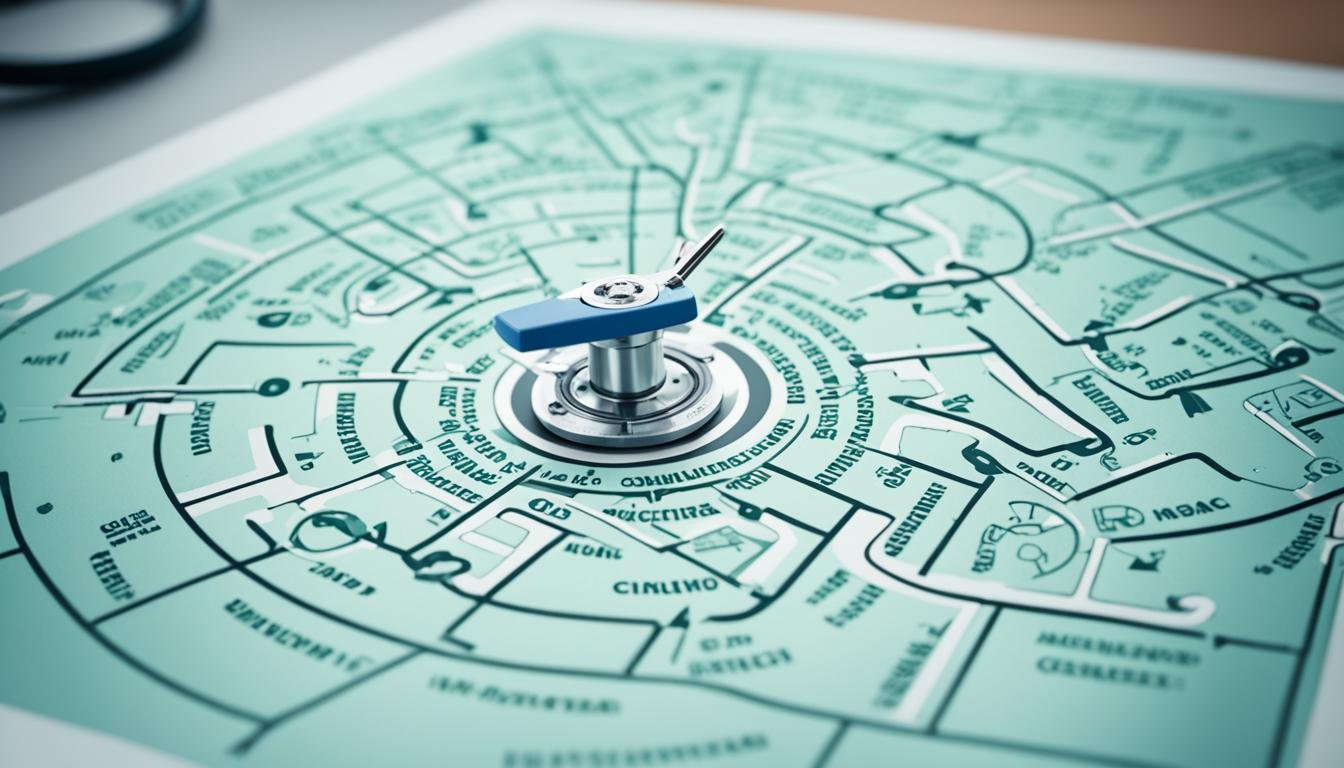Navigating the Medical Devices Regulation (MDR) for Irish Healthcare Institutions
Did you know, over 60 areas worldwide use the CE Mark? It shows medical devices meet European standards. This makes the Medical Devices Regulation (MDR) very important. It took full effect on May 26, 2021. For those in Ireland’s health sector, following the new MDR is key. The Health Products Regulatory Authority (HPRA) leads in checking medical devices. They ensure devices meet safety rules before selling, must have a Unique Device Identifier (UDI), and strict monitoring after.
Since May 2022, the In Vitro Diagnostics Regulation (IVDR) has also been part. Hospitals and institutes under Ireland’s Health Service Executive (HSE) need to know and act on these rules. The changes are tough for small and medium-sized businesses. Yet, they aim to make public health better and keep patients safe.
Key Takeaways
- The Medical Devices Regulation (MDR) became fully applicable on May 26, 2021.
- The HPRA is responsible for enforcing MDR and IVDR regulations in Ireland.
- MDR includes a UDI system for better traceability and enhanced market surveillance.
- Hospitals must comply with MDR requirements for reporting adverse incidents and reprocessing single-use devices.
- The European Commission aims for global convergence in medical device regulatory frameworks.
- Engaging stakeholders within healthcare institutions is essential for communicating new MDR regulatory requirements.
- Digital health advancements pose opportunities and challenges in complying with MDR guidelines.
Overview of the Medical Devices Regulation (MDR) and its Importance
The Medical Devices Regulation (MDR) started in 2017. It helps keep patients safe and updates how we deal with medical items in the EU. This rule improves the safety, quality, and efficiency of medical devices along with the In Vitro Diagnostic Regulation (IVDR).
Introduction to MDR and IVDR
The MDR and IVDR introduction aimed for stricter rules on medical devices. It stopped the old Medical Device Directive (MDD) from being used. Now, devices once certified under MDD must be re-certified by May 26, 2024, because of these new regulations.
The COVID-19 crisis delayed this process. So, high-risk devices have until December 31, 2027 to meet the rules. Medium to low-risk devices have even longer, until December 31, 2028.
Special devices, like Class III custom-made implantable items, have their own deadline. They must comply by May 26, 2026. These new rules show how important it is to keep standards high, even when facing global issues.
Significance of Compliance for Irish Healthcare Providers
For Irish healthcare providers, following the MDR is very important. It means they keep patients safe and meet their legal duties. The new Unique Device Identification (UDI) helps track medical items better. Adding more clinical data checks and implant cards also makes sure things run smoothly.
Places that make things need to be careful too. They must follow MDR to check their devices match the standards. This shows how much they need to know to deal with the new rules effectively.
Impacts of MDR on the Irish Healthcare System
The Medical Device Regulation (MDR), in effect since May 2021, has significantly changed the Irish healthcare system. One big change is how medical devices are checked and watched. There are now more rules about collecting clinical data. This is to make sure medical devices are safer before and after they’re allowed to be used.
Philips clinical project manager Deborah Ann Schuster shared that the extensive technical documentation requirements imposed by the MDR have disincentivized many SMEs from participating in prototype testing and trials.
The MDR has set up the European Databank on Medical Devices (EUDAMED) to collect data. It makes health protection better for people in the EU. But, devices that were already being sold aren’t automatically okay. They all have to go through serious clinical tests. This, plus the longer time for getting past the tests for older devices, shows a major change in how things are done.
The MDR’s rules affect many different groups. This includes small companies to big ones. Startups and smaller companies find these rules hard. They now have more paperwork to do. This might slow down how fast new medical devices are developed and used.
The MDR also makes things tougher for selling new high-risk devices. It includes some not common products under its rules too. Everyone involved in making or selling medical devices needs to take action to follow the MDR well. This prepares the Irish healthcare system to handle the MDR’s higher standards properly.
| Aspect | Impact |
|---|---|
| Clinical Data Requirements | Increased pre-approval and post-market data collection |
| Legacy Device Reapproval | Extended timeframe until 2027 for high-risk, 2028 for lower-risk devices |
| EUDAMED | Centralized data collection and monitoring |
| Innovation Challenges | Increased costs and efforts for compliance |
| Hospital Manufacturing Regulations | Three sets of regulatory requirements established |
Overall, the MDR creates a detailed system for safety and consistency. Irish healthcare groups need to understand and follow these rules well. This helps them stay safe and keep up with new ways to help people.
Understanding MDR Requirements for Irish Medical Devices
It’s key for those making or using medical devices in Ireland to know the MDR rules. The EU’s Medical Device Regulation (MDR) has been in place since May 26, 2021. Its goal is to make sure devices are safe and can be traced easily.
Classification of Medical Devices under MDR
Devices are sorted into four classes under MDR based on risk and how they interact with us. Here they are:
- Class I: Low-risk devices that can often be self-certified by the manufacturer.
- Class IIa: Medium-risk devices requiring a CE certificate from a Notified Body.
- Class IIb: Medium- to high-risk devices undergoing stringent control measures.
- Class III: High-risk devices, such as pacemakers, needing extensive clinical evaluation for CE marking.
Choosing the right category is crucial, making sure devices meet the rules before hitting the market. This helps everyone in Ireland’s healthcare smoothly follow MDR’s terms.
Key Steps to Ensure Compliance
To meet MDR’s demands, manufacturers and healthcare groups in Ireland must do certain things. Here are the steps they should take:
- Designation of Senior Operational Leads: Choose people to be in charge of following MDR rules.
- Engagement with Manufacturers: Work with device makers to ensure compliance.
- Assurance of UDI Database Entries: Keep the UDI database up-to-date.
- Electronic Record Maintenance: Keep detailed records for Class III devices.
- Incident Reporting Protocols: Set up ways to report accidents and near-misses.
- In-House Manufacturing Standards: Set guidelines for making or reusing devices on site.
Risk assessments are critical for meeting MDR standards. They must be part of the organization’s quality and safety planning.
Role of Unique Device Identification (UDI)
MDR brought in the UDI system, making device tracking and safety better in the EU. Class III devices must now have UDIs. This makes it easy to follow their journey from start to finish.
Benefits of UDI Implementation:
- Improves Device Traceability: Allows easy tracking of devices from maker to user.
- Enhances Patient Safety: Cuts down on fake or faulty devices in the market.
- Streamlines Recall Management: Makes handling product recalls and safety alerts easier.
Knowing MDR rules and using the UDI system means better safety and rules follow for Ireland’s healthcare. This also makes compliance easier.
Navigating the Medical Devices Regulation (MDR) for Irish Healthcare
Understanding the Medical Devices Regulation navigation is key for Irish healthcare. They are helped by the HPRA’s guidance and MDCG’s EU-level advice. With these resources, they can make the most of the rules.
In Ireland, healthcare providers must follow strict rules on medical devices. They need to have compliance leaders and keep track of UDI codes. Plus, they must give implant cards to patients. The UDI helpdesk is there to help fill in any gaps.
To understand Medical devices regulatory framework in Ireland, they use national and EU guides. These explain what healthcare groups must do. Groups like CAMD help everyone know and follow the rules.
Let’s look at some important facts about Irish healthcare and the Medical Devices Regulation:
| Category | Details |
|---|---|
| Health Budget for 2023 | €23.4 billion |
| Life Expectancy (2022) | 82.66 years |
| Healthcare Expenditure (2022) | €30.5 billion |
| Expenditure as Share of GDP (2022) | 6.1% |
| Hospital Beds per 1,000 Inhabitants (2022) | 3 |
| Healthcare Workers Recruited Since Sláintecare | 2,400+ |
| Digital Health Market Growth Projection | 200% in next three years |
| Digital Health Framework (2023-2030) | Introducing electronic patient records |
Dealing with the MDR transition challenges for healthcare providers is tough. As rules change fast, keeping up is a challenge. Providers must always update to stay compliant.
Using available tools and resources, Irish healthcare can tackle the Medical Devices Regulation. This leads to better care for patients all around.
Conclusion
The Medical Devices Regulation (MDR) became active on 26 May 2021. This changed the healthcare rules in the EU. Irish healthcare groups have to understand and follow these new rules. They aim to improve how things are done and make sure everyone does their part.
Healthcare groups in Ireland should know about the HPRA rules. Those making medical devices must register with the HPRA. This is for devices such as Class I, IIa, IIb, and some Class III. It’s crucial for Ireland to keep up with the MDR changes, especially with the new EUDAMED system coming in 2023.
Dealing with the MDR changes needs everyone in the medical device field to work together. The HPRA and others in Europe want to see more innovation while keeping patients safe. By staying up to date and being active, Ireland can lead in MedTech. It can also stay ahead in healthcare advancements in the EU.
Source Links
- Medical Devices Regulation (EU) 2017/745 and In Vitro Diagnostics Medical Devices Regulation (EU) 2017/746 – HSE.ie
- Navigating Medical Device Regulation with Boston Scientific’s Olga van Grol-Lawlor – VistaTalks Ep 127 –
- EU Medical Devices Regulations
- Medical Device Regulation (MDR)
- Medical devices and IVDs – regulatory documents and guidance
- The Medical Device Regulation and its impact on device development and research in Germany
- Is EU MDR harming medical device innovation?
- Hospitals as medical device manufacturers: keeping to the Medical Device Regulation (MDR) in the EU
- Regulation of devices in Northern Ireland
- Medical Devices Regulations and CE Marking
- How Are Medical Devices Classified Under EU MDR? | Remington
- Ireland – Healthcare
- A Guide to Navigating Regulatory Compliance for Medical Devices
- How is Europe’s MedTech industry navigating the EU MDR?
- Registration Requirements under the Medical Devices Regulation – Where Do We Stand? – WILLIAM FRY
- The MDR in Ireland: The Medical Devices Regulations 2021
- MSc in Regulatory Affairs for Medical Devices – Medicine








